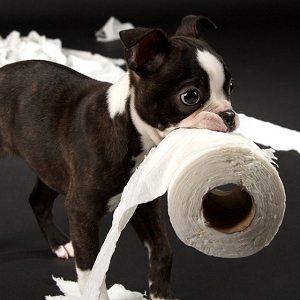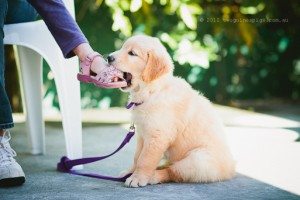Hi Meira,
We really need your help! We have an adorable 3 month old puppy named Mocha, who we love to bits! The only problem is that she is nipping us all the time, and we have no idea how to stop her. She has bitten both my boyfriend and I to the point of drawing blood, and has given us many scratches. This usually happens while we’re playing, but she also will bite at our feet when we’re walking around and even when we’re ignoring her and not playing.
We have tried telling her a firm NO, but that doesn’t seem to be working. We’ve tried yelping and saying OW, but that hasn’t been working either. At this point we don’t want to keep her in her crate, but we’ve tried everything, and we’re at our wits end. We love her a lot, she’s a very sweet puppy…but the teeth! Please, can you help us?
Thank you!
Sara
Hi Sara!
Thanks for writing in with your concerns. First off, congrats on your new puppy! Puppies can be so exciting, but can also be a bit of work. Believe me, you’re not the only one with puppy nipping problems. It’s one of the most common issues when people get their new pups. Actually, whenever I have a consult with a puppy, I always make sure not to wear new clothing, because I know that I will invariably end up with puppy tooth holes in my brand new shirt. It’s also why I’ve coined young puppies as Mako Mouths….they’re teeth are just so sharp at that age!
But Mother Nature has intended it that our puppies have little shark teeth until they are about five months of age, when they stop teething, and their adult teeth start growing in. It is up until this age of five months that puppies learn something called Bite Inhibition. Which means how strong or gently they should use their mouths. This is something they start learning when they are young and still with their dam and litter mates, but continues on when we bring them into our homes. And this is something that they need to learn. Because in the reality of it all, a dog’s jaws can cause serious damage. They can break bones and kill other creatures. So it is imperative that a puppy learns to have a soft mouth.
When puppies play, they use their mouths and their paws all the time. It’s the way they play. And they should use their mouths…a lot! Because this is actually how they learn their Bite Inhibition. When they are playing with their litter mates, and chomp down a little too hard, the other puppies stop playing with them because it hurts. And since puppies are so incredibly social, and they so desperately want to play, they learn how to control their mouths, so they can keep playing. That’s it pretty much in a nutshell.
So when we bring puppy home, she needs to learn how to play with a soft mouth. Remember that her idea of playing is with her mouth and her paws. It’s normal. We just need to teach them how we play, which isn’t the same way. And there are a few ways to do this.
One, we need to realize that dogs and puppies have chewing needs. And while I agree that those items shouldn’t be our feet, we do need to provide them with appropriate chew items. Rubber Nylabones are a great idea, as are rope toys, and chew toys that can be put into the fridge or freezer to help with the teething pain. I like deer antlers, but care needs to be taken, as they can chip or crack teeth in very hard chewers. I also love yak milk bones. Or any hard cheese bones. I’m not a big fan of raw hides, but if you do intend to give them, I’d choose the darker ones, and make sure they are dense…not those little chip like ones. Dogs don’t digest raw hide very well, and once they get near the end of them, they tend to swallow pieces that are just too large, which can cause a whole lot of problems. Dogs should be closely supervised with them. A lot of pups enjoying teething on hard pieces of blocks of wood, with sharp corners, that get to their back molars. This is why many a pup has gone after base boards and the bottoms of kitchen cupboards. Another good idea is to rotate their chewing options, so they don’t get bored.
Remember, if we don’t provide our puppies with appropriate chew items, they will chose them on their own, and I can guarantee you that you probably won’t approve of their choices.
Now we have to think of puppies playing needs. I don’t know how you play with your Mocha, but many people I work with use their hands when playing with their puppy. And most puppies reach around with their mouths as soon as people put their hands on them to play. There are a few things I’d do regarding this. First, I’d use a long toy to bridge the distance between the pups’ mouth and your hands. A long rope toy, a large stuffie, or a rubber chicken are all great options.
While playing with puppy, and pup uses teeth too hard on you, simply stop playing and remove yourself from the situation. There’s no need to say anything. Some people advise yelping like a puppy…but this doesn’t work with all puppies. I’ve seen this technique excite puppies even more actually. Almost as if the puppy thinks ‘omg, it squeaks!’ The strongest way to communicate to your pup that this type of behavior is not allowed is to remove yourself and end the play session. Removing yourself, as opposed to putting puppy in her crate for a time out, is a better option, as puppy needs to be reinforced, or needs to experience the consequence of the behavior within half a second of the behavior. And by the time you get a hold of puppy and put her in her crate means that the important rule of half a second has already passed. Removing yourself instead is much more instantaneous, which speaks much louder to your pup. Ideally, using a baby gate is best, so that puppy cannot follow you.
When you leave, you don’t have to leave for very long either. Puppies can’t think about what they’ve done. So make it short, just a few seconds, and then return. What matters most is the timing of when you leave her, which should be the very instant that her teeth are too hard on you. You may find that you need to do this a few times for puppy to get the hang of it. But you need to be consistent. Super consistent. Doing this only sometimes won’t teach puppy properly.
Another thing to keep in mind is how we move our hands around puppy. Most people aren’t very aware of how much they actually swing their arms around when moving. And this type of movement just excites puppy, and often entices them to jump up and grab the moving body parts. So keep your hands and arms steady. If you do have your hands close to puppy, it’s best to keep your hand in fists, so that puppy has less purchase ability on your hands. Open hands, with flailing fingers make for good sausages! A closed fist is harder to grab onto.
Again, remember that pups are reinforced within half a second of a behavior. So as soon as pup puts teeth on you, they are reinforced for doing so. They very act of doing it is reinforcing to the pup. So let’s try to avoid giving puppy chances to engage in the naughty behavior in the first place. Another thing that I often advise with new puppies is to cover your feet while in the house. Slippers or shoes make it harder for puppy to bite our feet, and results in less interaction from us.
If puppy is nipping as an attention seeking behavior, we need to make sure that we’re not reinforcing the behavior by giving the puppy the attention it’s seeking. We need to remember that negative attention, saying no, pushing them away, or even eye contact is still attention. And any type of attention with reinforce an attention seeking behavior. Instead, we can teach puppy appropriate attention seeking behavior, such as Sit instead. I find it much easier to teach puppy what we want them to do as opposed to teaching them what we don’t want them to do, because in teaching them what we don’t want them to do, we are often inadvertently reinforcing the very behavior we don’t want.
Puppies also need to learn and like having their bodies touched without having the need to put their mouths on you while you are touching them. This is best done while puppies mouths are otherwise occupied. Either with a toy, or a treat that they can sniff, lick and gnaw at. While mouth is busy, touch puppy on different body parts. Remove your hand and the toy or treat at the same time. Repeat and rinse many times, and you’ll teach puppy to accept and love being handled.
Again, congratulations on your new family addition! So long as you’re consistent, puppy should learn quite quickly. Good luck and Happy Training!
Meira
 Montreal Dog Blog Montreal's Online Dog Park
Montreal Dog Blog Montreal's Online Dog Park







